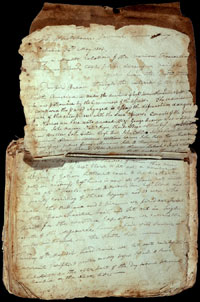Journey to the Bitterroot Valley
Who are the Salish?
Buying Salish Horses
The Salish Remember Lewis and Clark
| | |
Journey to the Bitterroot Valley
Private Joseph Whitehouse’s diary provides a vivid account of the expedition’s tense journey to the Bitterroot Valley. He described the tough passage over the mountains leading out of modern Idaho (September 3: “We lay down to sleep … Wet hungry and cold”) and the rapidly approaching winter (September 4: “Our mockersons froze hard.”) Finally, the terrain improved and their spirits rose. On September 20, the Americans entered the valley floor and, Whitehouse reported, “towards evening we arrived at a large encampment of the flat head nation [Salish].” Like the Shoshones, these Indians were en route to the buffalo country. But they had horses and were eager to form an alliance with the Americans.
After deserting the army in 1817, Joseph Whitehouse (1775?– ?) and his unpublished diary disappeared from history. In 1860, Canon di Vivaldi, an Italian priest, loaned the diary, which he claimed was a gift from Whitehouse, to the New York Historical Society. In 1893, a Mrs. Haley retrieved the document to settle a debt owed by Vivaldi. She later sold it to historian Reuben Gold Thwaites who used the journal when preparing his version of the expedition’s history in 1904. Thwaites later sold the journal to Chicago book collector and Newberry trustee Edward Ayer, who gave it to the Library.
In 1966 George W. White, a professor of geology at the University
of Illinois at Urbana-Champaign, discovered an edited transcription of
a previously unknown second volume of the journal in a Philadelphia bookstore.
Urged on by White and his Illinois colleague, historian Donald Jackson, the
Newberry added this unique item to its collections.
Joseph Whitehouse, Journal Commencing at the River Dubois, 1804-05.
|

|

